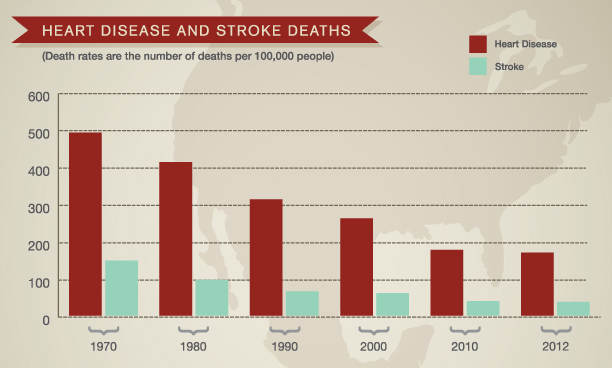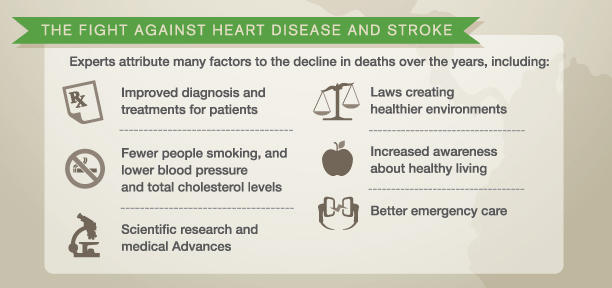"Something strange is going on in medicine," writes the New York Times's Gina Kolata - major diseases are are on the wane, and in some cases, it's a mystery as to why.
A decline in mortality from colon cancer is "especially perplexing," writes Kolata - a decline by nearly 50 percent since its peak in the 1980s has left researchers searching for an answer, since more screening couldn't possibly indicate such a large decline.
Heart disease mortality still declining, but slowing
Despite still being the number one cause of death in the world and the United States, death rates from cardiovascular disease and stroke have been steadily and significantly declining since the 1970s.
From 2000 to 2010, age-adjusted mortality decreased 30 percent for heart disease and 36 percent for stoke. And with cancer mortality declining by only 13 percent over that time period, it looked as if heart disease might lose its status as leading cause of death in the United States for the first time since 1910.
Not so fast.

Cardiovascular mortality is still declining - but recent trends published in JAMA Cardiology suggest that declines are slowing down "dramatically" - leaving the American Heart Association's goal of reducing cardiovascular deaths by 20 percent between 2010 and 2020 seemingly out of reach.
Warning signs such as this are often used to suggest a pending "epidemic" of heart disease. That leads to murky projections, or even new policy initiatives and investments---based on those projections---designed to get ahead of new, rising risk factors.
With heart disease, decline might only seem more explicable
With heart disease, as opposed to colon cancer, it's tempting to take the simple causal answers at face value, since heart disease as a public health issue has been talked about and studied for so long. (More on that next time.)
To answer the question---why is the decline slowing?---maybe the end-all be-all answer is the straightforward one: obesity and diabetes are beginning to take their toll on the decline, while prevention measures are reaching saturation:
"It is possible that the early part of the 21st century experienced a particularly high rate of decline in CVD mortality because of the implementation of the prevention programs noted earlier and that the decline might have slowed as implementation approached a saturation level in the community," write the authors of the JAMA Cardiology report.
Or perhaps, it's even more tempting to accept a slightly more complicated, but still simplified, matrix of factors from empirical models:

But the history of the heart disease decline, and how it's measured, isn't so simple.
"The heart disease effect has been examined by scientist after scientist," writes Kolata. "Was it a result of better prevention, treatment, lifestyle changes? All three played a role, researchers said."
And are those roles really quantifiable?
Assigning causality to broad changes in public health statistics, and projecting changes into the future, is often largely fruitless in terms of policy guidance. We are left with big, unanswerable questions:
- What's the best way to maintain or re-energize declines in heart disease mortality?
- How do we allocate resources efficiently to obtain such large-scale outcomes?
And despite all the research and measurement into heart disease on a national and global scale - are we any closer to satisfying answers to these questions?
"It’s not as if the waxing and waning of diseases has never happened before," writes Kolata. "And all too often these medical mysteries remain mysteries."
ACVP blog will look into the history of the great heart disease mortality decline - and hopefully shed some light on this particular medical mystery - next Monday.
In the meantime, how would you answer these unanswerables? What is your practice doing to lower heart disease mortality? Leave a comment!
